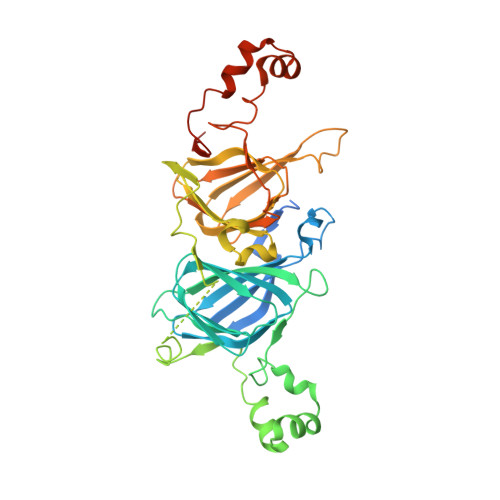Comparative study of 7S globulin from Corylus avellana and Solanum lycopersicum revealed importance of salicylic acid and Cu-binding loop in modulating their function.
Shikhi, M., Jain, A., Salunke, D.M.(2020) Biochem Biophys Res Commun 522: 127-132
- PubMed: 31753489
- DOI: https://doi.org/10.1016/j.bbrc.2019.11.072
- Primary Citation of Related Structures:
6L4C, 6L4M - PubMed Abstract:
The plant seed proteins referred to as vicilins belong to a structurally common superfamily. While some of them are reported to exhibit superoxide dismutase activity, vicilins from other sources do not possess this activity. Vicilin from Corylus avellana (HZ.1) and Solanum lycopersicum (SL80.1) were purified and subjected to structure-function analysis. The superoxide dismutase activity assays were performed to understand the functional differences between them. While SL80.1 has the superoxide dismutase activity, HZ.1 was enzymatically inactive. Crystal structure followed by mass spectrometry analysis of both the proteins revealed that while SL80.1 has bound salicylic acid, HZ.1 does not. Comparison of C-terminal binding pocket of both the structures revealed that a point mutation at residue 321 in HZ.1 (Gly→Cys) leads to obstruction in binding of salicylic acid in the pocket. Similarly, copper-binding loop of HZ.1 was reportedly found to be intact and shorter than the loops reported in SL80.1. The copper-binding loop of SL80.1 is rich in polar residues and the absence of these residues in HZ.1 copper-binding loop possibly indicates deficiency in channeling of oxygen radicals to the active center of the enzyme. Difference in the enzymatic activity of vicilin from two evolutionarily distinct sources is due to mutations in its co-factor binding pocket and copper-binding loop.
- Regional Centre for Biotechnology, NCR Biotech Science Cluster, 3rd Milestone, Faridabad-Gurgaon Expressway, Faridabad, 121 001, India; Kalinga Institute of Industrial Technology, Bhubaneswar, Odisha, 751024, India.
Organizational Affiliation:

















